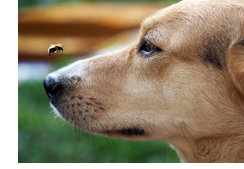
The onset of warmer spring weather also brings a burst of flowering plants and trees, which means there are more bees buzzing around. Pets, especially dogs, can come into contact with bees that have fallen to the ground, or from exploring in and amongst the flowering plants in the garden or in bushland.
Signs of a bee sting
Bee stings are not only painful, they can also cause a rapid onset allergic reaction with pain, swelling, and potential lameness or breathing difficulties. Pets will often lick at the site of the bee sting.
There may also be some swelling and tenderness at the sting site, so if the pet allows you to check for it, removing the sting can be useful. A cold compress or ice pack can also help on the sting site, but this can often be difficult to apply if the pet is in pain.
Get your pet to the vet
If your pet becomes lethargic or shows any signs of swelling, especially if the swelling is around their head or face, which may impact their breathing, then it is important to seek veterinary attention as soon as possible.
We often treat bee stings with an antihistamine and anti-inflammatory or pain relief injections. Some pets can have severe anaphylactic reactions to bee stings, so it’s vital to always get your pet seen by a vet as soon as you can.
To help prevent bee stings, try to keep your pet away from flowering trees and plants, and discourage them from playing with or chasing bees.
For further advice on bee stings in pets, please contact our Pet Doctors’ team on 5576 0400.

